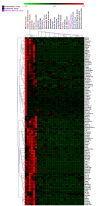Bioinformatic identification and characterization of human endothelial cell-restricted genes
- PMID: 20509943
- PMCID: PMC2887814
- DOI: 10.1186/1471-2164-11-342
Bioinformatic identification and characterization of human endothelial cell-restricted genes
Abstract
Background: In this study, we used a systematic bioinformatics analysis approach to elucidate genes that exhibit an endothelial cell (EC) restricted expression pattern, and began to define their regulation, tissue distribution, and potential biological role.
Results: Using a high throughput microarray platform, a primary set of 1,191 transcripts that are enriched in different primary ECs compared to non-ECs was identified (LCB >3, FDR <2%). Further refinement of this initial subset of transcripts, using published data, yielded 152 transcripts (representing 109 genes) with different degrees of EC-specificity. Several interesting patterns emerged among these genes: some were expressed in all ECs and several were restricted to microvascular ECs. Pathway analysis and gene ontology demonstrated that several of the identified genes are known to be involved in vasculature development, angiogenesis, and endothelial function (P < 0.01). These genes are enriched in cardiovascular diseases, hemorrhage and ischemia gene sets (P < 0.001). Most of the identified genes are ubiquitously expressed in many different tissues. Analysis of the proximal promoter revealed the enrichment of conserved binding sites for 26 different transcription factors and analysis of the untranslated regions suggests that a subset of the EC-restricted genes are targets of 15 microRNAs. While many of the identified genes are known for their regulatory role in ECs, we have also identified several novel EC-restricted genes, the function of which have yet to be fully defined.
Conclusion: The study provides an initial catalogue of EC-restricted genes most of which are ubiquitously expressed in different endothelial cells.
Figures








References
-
- Cines DB, Pollak ES, Buck CA, Loscalzo J, Zimmerman GA, McEver RP, Pober JS, Wick TM, Konkle BA, Schwartz BS. et al.Endothelial cells in physiology and in the pathophysiology of vascular disorders. Blood. 1998;91(10):3527–3561. - PubMed
-
- Choi YK, Kim KW. Blood-neural barrier: its diversity and coordinated cell-to-cell communication. BMB Rep. 2008;41(5):345–352. - PubMed
Publication types
MeSH terms
Substances
Grants and funding
LinkOut - more resources
Full Text Sources
Other Literature Sources
Medical

